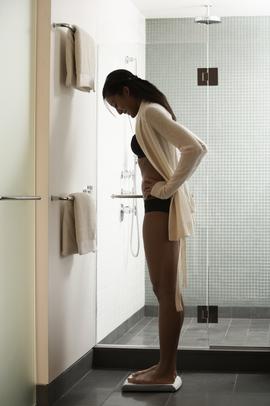
This article appeared in LiveHealthy.Chron.com (Click here to view original article)
Your body needs some stored fat to function properly, but too much can put your health at risk. You can measure your percentage of body fat with a variety of different machines, including handheld body fat analyzers, body fat scales, skin-fold calipers, DEXA scans, Bod Pods and hydrostatic weighing. Some of these tools, like handheld analyzers and scales, can be used at home, while others are available at a doctor’s office or health club.
At-Home Body Fat Analyzers
Handheld analyzers and body fat scales are electronic analyzers that can be used at home to measure your percentage of body fat. These machines use bioelectric impedance to calculate your body fat. They pass a very low level of electricity through your body and measure the resistance. The electricity travels through fat slower than it does muscle and other fat-free body mass, so the machine can estimate the amount of fat based on the rate that the electricity moves through your body.
Ideal Body Fat Percentages
Men tend to have lower body fat percentages than women. According to research published in the “American Journal of Clinical Nutrition,” ideal body fat percentages for men between the ages of 20 and 40 range from 8 to 19 percent. For women in that same age group, the ideal percentage ranges from 21 to 33. As you get older, the percentage of fat in your body tends to increase. For men over 60 years of age, ideal percentages range from 13 to 25 and for women over 60, those numbers increase to between 24 and 36.
Limitations of Machines That Measure Body Fat
Even the most accurate method of measuring body fat percentage — hydrostatic weighing — has limitations in terms of precise measurements. Body fat scales and handheld analyzers can only provide estimates of your body fat, so you should use these devices as motivational tools rather than precision instruments. Because body fat scales measure the electrical impedance up through your feet and back down, they tend to give a better estimate of your lower body fat. For the same reason, handheld analyzers tend to measure your upper body fat. Your weight and body fat measurements fluctuate throughout the day and are influenced by such factors as hydration, when you last ate, the clothes you’re wearing, recent exercise, your body type, temperature and the room temperature.
Tips for Success
Always measure yourself at the same time of day under similar circumstances, and track trends instead of exact numbers. A loss of 1 percent of body fat per month is considered safe, but the measurement error of the machines can easily equal that. Instead of obsessing over weekly numbers, recheck your body composition every couple of months for best results. When you are trying to lose weight, you want to lose fat, not muscle. By measuring the amount of body fat in your body at different points in time and comparing that to your weight each time, you can get a good idea of how much fat your body burned. If your body fat percentage doesn’t go down but your weight does, you are probably losing muscle weight, which actually slows down your metabolism. If you are losing muscle instead of fat, you should make changes to your eating and exercise habits.
References (3)
- Fitech: Measuring Body Composition: Why do I need to Monitor My Body Fat?
- The American Journal of Clinical Nutrition: Healthy Percentage Body Fat Ranges: An Approach for Developing Guidelines Based on Body Mass Index
- American Council on Exercise:What are the guidelines for percentage of body fat loss?
Photo Credits
- Thomas Northcut/Digital Vision/Getty Images



